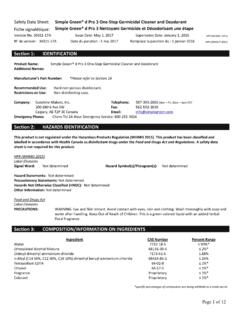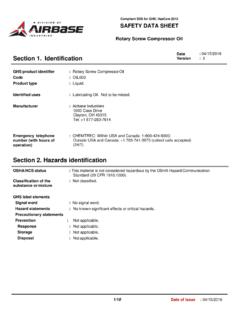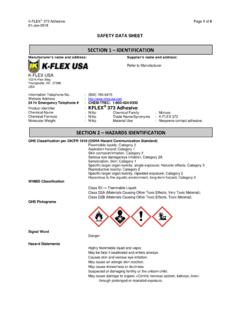Transcription of Section 1 Identification - ussteel.com
1 Page 1 of 7 Mill Scale Safety Data Sheet (SDS) USS IHS Number: 41 Locations: Fairfield, Gary, Granite City, Great Lakes, Hamilton, Lorain, Lake Erie, and Mon Valley Original: 12/16/2010 Revision: 7/01/2017 Expiration: 7/01/2020 Section 1 Identification 1(a) Product Identifier used on Label: Mill Scale 1(b) Other Means of Identification : Scale, Roll Scale, Hot Strip Mill Scale, Caster Scale, Continuous Caster Scale, Oily Mill Scale 1(c) Recommended use of the chemical and restrictions on use: None 1(d) Name, Address, and Telephone Number: United States Steel Corporation 600 Grant Street, Room 1662 Pittsburgh, PA 15219-2800 Phone number: (412) 433-6840 (8:00 am to 5:00 pm) FAX: (412) 433-5019 1(e) Emergency Phone Number: 1-800-262-8200 (CHEMTREC) Section 2 Hazard(s) Identification 2(a) Classification of the Chemical: Mill Scale is considered a hazardous material according to the criteria specified in REACH [REGULATION (EC) No 1907/2006] and CLP [REGULATION (EC) No 1272/2008] and OSHA 29 CFR Hazard Communication Standard.
2 The categories of Health Hazards as defined in GLOBALLY HARMONIZED SYSTEM OF CLASSIFICATION AND LABELLING OF CHEMICALS (GHS), Third revised edition ST/ 3 United Nations, New York and Geneva, 2009 have been evaluated. Refer to Section 3, 8 and 11 for additional information. 2(b) Signal Word, Hazard Statement(s), Symbols and Precautionary Statement(s): Hazard Symbol Hazard Classification Signal Word Hazard Statement(s) Precautionary Statement(s) Carcinogenicity - 1A Danger May cause cancer. Wear protective gloves/protective clothing/eye protection/face protection. Obtain special instructions before use. Do not handle until all safety precautions have been read and understood. If exposed or concerned: Get medical advice/attention. Dispose of contents in accordance with federal, state and local regulations. Store locked up. 2(c) Hazards not Otherwise Classified: None Known 2(d) Unknown Acute Toxicity Statement (Mixture): None Known Section 3 Composition/Information on Ingredients Mill Scale, ferrous metal, blast furnace 65996-74-9 266-007-8 100% The following components comprise this product and were used for hazard determination: Iron and Iron Oxides 7439-89-6 1345-25-1 1309-38-2 1309-37-1 231-096-4 215-721-8 215-169-8 215-168-2 70-99 Crystalline Silica (as Quartz) 14808-60-7 238-878-4 EC- European Community CAS- Chemical Abstract Service Mill Scale USS IHS No.
3 : 41 Rev. 7/17 Page 2 of 7 Section 4 First-aid Measures 4(a) Description of necessary measures: If exposed, concerned: Get medical advice/attention. Inhalation: If inhaled: Remove person to fresh air and keep comfortable for breathing. Eye Contact: If in eyes: Rinse cautiously with water for several minutes. Remove contact lenses, if present and easy to do. Continue Rinsing. Skin Contact: If on skin: Wash with plenty of water. Ingestion: If swallowed: Call a poison center or doctor/physician if you feel unwell. 4(b) Most Important Symptoms/Effects, Acute and Delayed (Chronic): Acute effects: Inhalation: Excessive exposure to high concentrations of dust may cause irritation to the mucous membranes of the upper respiratory tract. Eye: Particles of iron or iron compounds may become imbedded in the eye. Excessive exposure to high concentrations of dust may cause irritation to the eyes.
4 Skin: Skin contact with dusts may cause irritation or sensitization, possibly leading to dermatitis. Skin contact with metallic dusts may cause physical abrasion. Ingestion: Ingestion of dust may cause nausea and/or vomiting. Chronic Effects: Individuals with chronic respiratory disorders ( , asthma, chronic bronchitis, emphysema, etc.) may be adversely affected by any airborne particulate matter exposure. Persons with pre-existing skin disorders may be more susceptible to dermatitis. 4(c) Immediate Medical Attention and Special Treatment: Treat symptomatically. Section 5 Fire-fighting Measures 5(a) Suitable (and Unsuitable) Extinguishing Media: Use extinguishers appropriate for surrounding materials.. 5(b) Specific Hazards Arising from the Chemical: Incompatibility (materials to avoid), heat and flames. When burned, toxic smoke and vapor may be emitted including, oxides of carbon, metal oxides and other toxic vapors.
5 5(c) Special Protective Equipment and Precautions for Fire-fighters: Self-contained NIOSH approved respiratory protection and full protective clothing should be worn when fumes and/or smoke from fire are present. Heat and flames cause emittance of acrid smoke and fumes. Do not release runoff from fire control methods into sewers or waterways. Firefighters should wear full face-piece self-contained breathing apparatus and chemical protective clothing with thermal protection. Direct water stream will scatter and spread flames and, therefore, should not be used. Section 6 - Accidental Release Measures 6(a) Personal Precautions, Protective Equipment and Emergency Procedures: For spills involving finely divided particles, clean-up personnel should be protected against contact with eyes and skin. If material is in a dry state, avoid inhalation of dust.
6 Personnel should be protected against contact with eyes and skin. Fine, dry material should be removed by vacuuming or wet sweeping methods to prevent spreading of dust. Avoid using compressed air. Do not release into sewers or waterways. Collect material in appropriate, labeled containers for recovery or disposal in accordance with federal, state, and local regulations. 6(b) Methods and Materials for Containment and Clean Up: Collect material in appropriate, labeled containers for recovery or disposal in accordance with federal, state, and local regulations. Follow applicable OSHA regulations (29 CFR ) and all other pertinent state and federal requirements. Section 7 - Handling and Storage 7(a) Precautions for Safe Handling: Do not eat, drink or smoke when using this product. Wash thoroughly after handling. Do not breathe dusts. Wear protective gloves / protective clothing / eye protection / face protection.
7 Obtain special instructions before use. Do not handle until all safety precautions have been read and understood. Avoid direct contact on skin, eyes or on clothing. Emergency safety showers and eye wash stations should be present. 7(b) Conditions for Safe Storage, including any Incompatibilities: Whenever feasible, store locked up. Section 8 - Exposure Controls / Personal Protection 8(a) Occupational Exposure Limits (OELs): The following exposure limits are offered as reference, for an experience industrial hygienist to review. Ingredients OSHA PEL 1 ACGIH TLV 2 NIOSH REL 3 IDLH 4 Iron and Iron Oxides 10 mg/m (as iron oxide fume) mg/m mg/m (as iron oxide dust and fume) 2,500 mg/m3 Crystalline Silica (as Quartz) (30mg/m )/(%SiO2 + 2) (as total dust) (10mg/m )/(%SiO2 + 2) (as respirable fraction) mg/m3 mg/m 50 mg/m NE - None Established Mill Scale USS IHS No.
8 : 41 Rev. 7/17 Page 3 of 7 Section 8 - Exposure Controls / Personal Protection (continued) 8(a) Occupational Exposure Limits (OELs) (continued): 1. OSHA PELs (Permissible Exposure Limits) are 8-hour TWA (time-weighted average) concentrations unless otherwise noted. A ( C ) designation denotes a ceiling limit, which should not be exceeded during any part of the working exposure unless otherwise noted. An Action level (AL) is used by OSHA and NIOSH to express a health or physical hazard. They indicate the level of a harmful or toxic substance/activity, which requires medical surveillance, increased industrial hygiene monitoring, or biological monitoring. Action Levels are generally set at one half of the PEL but the actual level may vary from standard to standard. The intent is to identify a level at which the vast majority of randomly sampled exposures will be below the PEL.
9 2. Threshold Limit Values (TLV) established by the American Conference of Governmental Industrial Hygienists (ACGIH) are 8-hour TWA concentrations unless otherwise noted. ACGIH TLVs are for guideline purposes only and as such are not legal, regulatory limits for compliance purposes. A Short Term Exposure Limit (STEL) is defined as the maximum concentration to which workers can be exposed for a short period of time (15 minutes) for only four times throughout the day with at least one hour between exposures. 3. The National Institute for Occupational Safety and Health Recommended Exposure Limits (NIOSH-REL) - Compendium of Policy and Statements. NIOSH, Cincinnati, OH (1992). NIOSH is the federal agency designated to conduct research relative to occupational safety and health. As is the case with ACGIH TLVs, NIOSH RELs are for guideline purposes only and as such are not legal, regulatory limits for compliance purposes.
10 4. The "immediately dangerous to life or health air concentration values (IDLHs)" are used by NIOSH as part of the respirator selection criteria and were first developed in the mid-1970's by NIOSH. The Documentation for Immediately Dangerous to Life or Health Concentrations (IDLHs) is a compilation of the rationale and sources of information used by NIOSH during the original determination of 387 IDLHs and their subsequent review and revision in 1994. 8(b) Appropriate Engineering Controls: Local exhaust ventilation should be used to control the emission of air contaminants. General dilution ventilation may assist with the reduction of air contaminant concentrations. Emergency eye wash stations and deluge safety showers should be available in the work area. 8(c) Individual Protection Measures: Respiratory Protection: Seek professional advice prior to respirator selection and use.









